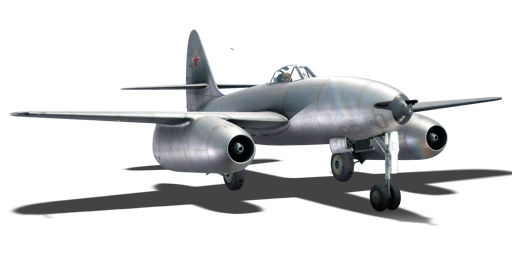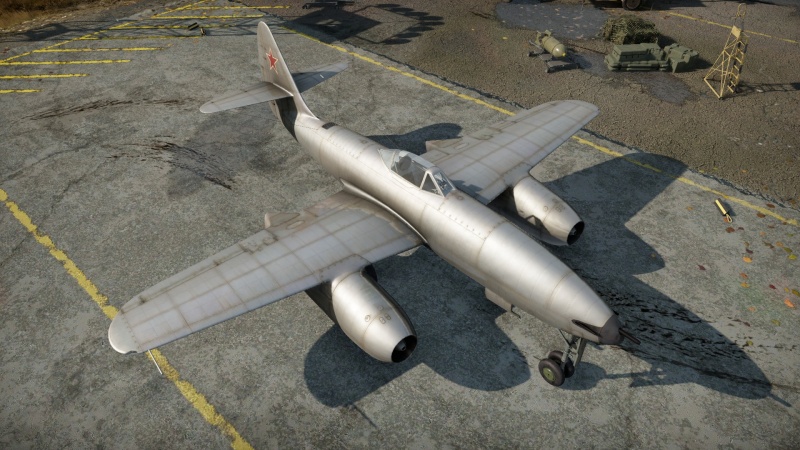Su-9
Contents
Description
The Su-9 is a rank V Soviet jet fighter with a battle rating of 7.3 (AB) and 7.0 (RB/SB). It was introduced in Update "Ixwa Strike".
General info
Flight performance
Describe how the aircraft behaves in the air. Speed, manoeuvrability, acceleration and allowable loads - these are the most important characteristics of the vehicle.
| Characteristics | Max Speed (km/h at 6,000 m) |
Max altitude (metres) |
Turn time (seconds) |
Rate of climb (metres/second) |
Take-off run (metres) | |||
|---|---|---|---|---|---|---|---|---|
| AB | RB | AB | RB | AB | RB | |||
| Stock | 855 | 818 | 12400 | 29.4 | 31.0 | 15.7 | 15.7 | 1,000 |
| Upgraded | 927 | 886 | 28.8 | 29.0 | 27.4 | 21.0 | ||
Details
| Features | |||||
|---|---|---|---|---|---|
| Combat flaps | Take-off flaps | Landing flaps | Air brakes | Arrestor gear | Drogue chute |
| ✓ | ✓ | ✓ | ✓ | X | X |
| Limits | ||||||
|---|---|---|---|---|---|---|
| Wings (km/h) | Gear (km/h) | Flaps (km/h) | Max Static G | |||
| Combat | Take-off | Landing | + | - | ||
| 1025 | 420 | 558 | 529 | 380 | ~12 | ~4 |
| Optimal velocities (km/h) | |||
|---|---|---|---|
| Ailerons | Rudder | Elevators | Radiator |
| < 480 | < 580 | < 660 | N/A |
Engine performance
| Engine | Aircraft mass | |||||||
|---|---|---|---|---|---|---|---|---|
| Engine name | Number | Basic mass | Wing loading (full fuel) | |||||
| Klimov RD-10 | 2 | 4,175 kg | 288 kg/m2 | |||||
| Engine characteristics | Mass with fuel (no weapons load) | Max Takeoff Weight | ||||||
| Weight (each) | Type | 15m fuel | 20m fuel | 30m fuel | 45m fuel | 50m fuel | ||
| 760 kg | Axial-flow turbojet | 4,729 kg | 4,904 kg | 5,268 kg | 5,815 kg | 6,021 kg | 6,520 kg | |
| Maximum engine thrust @ 0 m (RB / SB) | Thrust to weight ratio @ 0 m (100%) | |||||||
| Condition | 100% | WEP | 15m fuel | 20m fuel | 30m fuel | 45m fuel | 50m fuel | MTOW |
| Stationary | 874 kgf | N/A | 0.37 | 0.36 | 0.33 | 0.30 | 0.29 | 0.27 |
| Optimal | 874 kgf (0 km/h) |
N/A | 0.37 | 0.36 | 0.33 | 0.30 | 0.29 | 0.27 |
Survivability and armour
- 6 mm steel above pilot's head
- 12 mm steel headrest
- 12 mm steel behind pilot
- 15 mm steel behind frontal fuel tank
- 15 mm steel in front of armament
- 90 mm bulletproof glass in front of pilot
- Self-sealing fuel tanks (1 cleaver-shaped one behind pilot, 1 cleaver-shaped one in front of pilot)
Modifications and economy
Armaments
Offensive armament
The Su-9 is armed with:
- 1 x 37 mm N-37 cannon, nose-mounted (40 rpg)
- 2 x 23 mm NS-23 cannons, nose-mounted (100 rpg = 200 total)
Suspended armament
The Su-9 can be outfitted with the following ordnance:
- Without load
- 1 x 250 kg FAB-250M-46 bomb (250 kg total)
- 2 x 250 kg FAB-250M-46 bombs (500 kg total)
- 1 x 500 kg FAB-500M-46 bomb (500 kg total)
Usage in battles
Air RB
This plane has great firepower but always watch the ammo count so you won't run out of bullets. The plane has 90 mm of bulletproof glass in front of the pilot, so your pilot has a high chance of survival in head-ons. Once the plane gets up to speed, it becomes a great bomber hunter. Keep in mind that this plane has a slow acceleration. Use HE belt or air targets belt as it will shred enemy aircraft in pieces with just a few well-aimed shots.
Ground RB
The Su-9 is capable of destroying ground targets with its suspended armament. When dive bombing, don't pull of to late as the engines aren't that powerful. It is possible to destroy some light and medium tanks with the right ammunition belt. For destroying tanks, top-down approaches are heavily recommended.
Pros and cons
Pros:
- Powerful offensive armament
- Airbrakes
Cons:
- Bad acceleration and bad climb rate
- Low ammunition count
- Very sluggish with suspended armament
History
In 1944, the Sukhoi design bureau began designing a twin-engined fighter powered by two Lyulka TR-1 turbojets. The overall design was likely influenced by a a captured Messerschmitt Me 262, but it was not a copy of the German aircraft. The Su-9 had an oval cross-section, all-metal stressed skin monocoque fuselage that housed a single cockpit. The pilot was protected by armor plates to his front, an armored seat back and a bulletproof windscreen for the bubble canopy. He was provided with an ejection seat, copied from that used in the Heinkel He 162. The aircraft carried a total of 1,350 kilograms (2,980 lb) of fuel in two bladder tanks, one each ahead and behind the pilot.
The low-mounted, straight wing had a single-spar and a slight dihedral of 4°20'. The outer flaps were split and could act as air brakes. The Su-9 was the first Soviet aircraft to use hydraulic-powered controls. A Soviet copy of the Junkers Jumo 004B turbojet, known as the RD-10, was hung under each wing in a streamlined nacelle. The aircraft had a tricycle undercarriage that retracted into the fuselage. The Su-9 was designed with a very high wing loading which increased the aircraft's speed and reduced its dimensions. This consequently increased the take-off and landing speeds so it was equipped with a provision for two JATO bottles (11.27 kN (530 lbf) thrust for 8 seconds) mounted on the sides of the fuselage. These reduced the take-off distance by nearly 50 percent and a braking parachute was fitted to reduce the landing distance.
The nose housed the armament of one 37-millimeter (1.5 in) Nudelman N-37 autocannon and two 23-millimeter (0.91 in) Nudelman-Suranov NS-23 autocannons. The N-37 could be replaced by a 45-millimeter (1.8 in) Nudelman-Suranov NS-45. The aircraft carried 100 rounds for each NS-23 and 40 rounds for the N-37. Two 250-kilogram (550 lb) FAB-250 high explosive bombs could be carried underneath the forward fuselage, but the N-37 had to be dismounted to do so.
As the TR-1 engines originally intended for the Su-9 were not yet ready for flight testing in late 1945, Pavel Sukhoi suggested substituting a pair of Jumo 004 engines and this was approved on 15 December. The full-scale mockup was found to be acceptable on 16 February 1946. This goal was not met because the OKB was heavily committed to other projects , inexperience with JATO units, and late delivery of RD-10 engines. The first prototype was completed in mid-October and made its first flight on 13 November. The test pilots found the aircraft easy to fly, but the control forces were very high at speed and it lacked enough directional stability. Enlarging the vertical stabilizer cured this last problem and hydraulic boosters were fitted for the control system.
The aircraft was revealed to the general public on 3 August 1947 at a flypast at Moscow's Tushino Airfield and the aircraft began its state acceptance trials three days later. Flight testing was completed by 25 May 1948 after 136 flights had been completed. It demonstrated a top speed of 885 kilometers per hour (550 mph) at an altitude of 8,000 meters (26,250 ft) and an endurance of one hour and 44 minutes. It had very docile handling qualities with one engine inoperative. The aircraft was recommended for production, but it was significantly slower than the Mikoyan-Gurevich MiG-9 and Yakovlev Yak-15. The government declined to do so and the program was terminated.[1]
Media
- Skins
- Videos
See also
External links
| Sukhoi Design Bureau (Сухого Опытное конструкторское бюро) | |
|---|---|
| Jet fighters | Su-9 · Su-11 |
| Su-27 | Su-27 · Su-27SM |
| Strike aircraft | |
| Su-2 | BB-1 · Su-2 (M-82) · Su-2 MV-5 · Su-2 TSS-1 |
| Su-6 | Su-6 · Su-6 (AM-42) · Su-6 (M-71F) |
| Su-7 | Su-7B · Su-7BKL · Su-7BMK |
| Su-8 | Su-8 |
| Su-17 | Su-17M2 · Su-17M4 · Su-22M3 |
| Su-24 | Su-24M |
| Su-25 | Su-25 · Su-25BM · Su-25K · Su-25T · Su-25SM3 · Su-39 |
| Su-34 | Su-34 |
| Export | ◊Su-22UM3K · ◔Su-22M3 · ◊Su-22M4 · ◄Su-22M4 WTD61 |
| J-11* | |
| *CKD and SKD kits assembled by Shenyang Aircraft Corporation | |
| USSR jet aircraft | |
|---|---|
| Bereznyak-Isayev | BI |
| Yakovlev | Yak-15 · Yak-15P · Yak-17 · Yak-23 · Yak-28B · Yak-30D · Yak-38 · Yak-38M · Yak-141 |
| Mikoyan-Gurevich | MiG-9 · MiG-9 (l) · MiG-15 · MiG-15bis · MiG-15bis ISh · MiG-17 · MiG-17AS · MiG-19PT |
| MiG-21F-13 · MiG-21PFM · MiG-21S (R-13-300) · MiG-21SMT · MiG-21bis | |
| MiG-23M · MiG-23ML · MiG-23MLD · MiG-27M · MiG-27K | |
| MiG-29 · MiG-29SMT | |
| Lavochkin | La-174 · La-15 · La-200 |
| Sukhoi | Su-9 · Su-11 |
| Su-7B · Su-7BKL · Su-7BMK · Su-17M2 · Su-17M4 · Su-22M3 | |
| Su-24M | |
| Su-25 · Su-25BM · Su-25K · Su-25T · Su-25SM3 · Su-39 | |
| Su-27 · Su-27SM | |
| Su-34 | |
| Ilyushin | IL-28 · IL-28Sh |
| Tupolev | Tu-14T |





